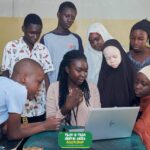Over the years, sub-Saharan Africa has witnessed different forms of violent conflicts and wars that have resulted in countless loss of lives and displacements. In these conflicts, opponents have not only deployed physical weaponry to subdue their opponents. Often, rape, mostly targeted at women and girls, has been used as a weapon in these conflicts.
Throughout history, rape and other forms of sexual violence have been utilised as war tactics by armed groups and parties to terrorise, victimise, and subject women to fear and silence.
According to the United Nations, or UN, between 100,000 and 250,000 women and girls were raped during the 1994 Rwandan genocide, while 60,000 women and girls were equally raped in the Sierra Leonean civil war from 1991 to 2002. The first and second Liberian civil wars between 1989 and 2003 also recorded over 40,000 cases of rape.
Rape and other forms of sexual violence can occur in any given situation. Still, they tend to increase during situations of war and conflict, according to Derby Collins-Kalu, a Nigeria-based women’s rights activist.
“Conflicts and wars increase rape and other forms of gender-based violence for women and girls because they are usually the most vulnerable population. Women are on the lowest cadre of strata in society, and that is why they are always affected,” she said.
Also, during conflicts and wars, women and girls are usually unable to defend themselves because of their vulnerability, making it easy for them to be sexually abused. “Since women are vulnerable and, most times, do not have access to resources and weaponry to defend themselves in situations of conflict, they become tools of sexual abuse in such situations, leaving them with psychological trauma afterwards,” Nkoyo Toyo, former Nigerian Ambassador to Ethiopia and founder of the Gender and Development Action or GADA, said.
This analysis examines the increasing trend of sexual violence in recent and ongoing conflicts in Sudan, South Sudan, the Democratic Republic of the Congo, Cameroon, and Nigeria.
Sudan
After going through two civil wars, Sudan witnessed a regional war in Darfur in 2003, which has lingered to date. Between October 2004 and the first half of February 2005, doctors from Médecins Sans Frontières, or MSF, said they treated almost 500 rape victims, mostly females, in the Darfur region. In October 2014, it was reported that 221 women and girls were mass raped by soldiers in Darfur.
Fresh conflict broke out in Sudan’s capital, Khartoum, on April 15, this year, between the Sudanese Army and the Rapid Support Forces—a paramilitary group. The conflict, which is a power struggle between generals of both armed groups, has recorded casualties, including about 7000 deaths, over six million internal and external displacements, and many cases of rape-Sudan’s Ministry of Social Justice announced in July that it had recorded 56 and 31 cases of rape in the ongoing conflict in Khartoum and Darfur respectively. By September, the figures had gone up to 68 cases in Khartoum and 136 cases across Sudan.
With the conflict still ongoing, women and girls in the country are still not safe and will continue to be primary targets of rape and other forms of sexual and gender-based violence.
South Sudan
Until July 2011, when it gained independence, South Sudan existed as a region in Sudan and witnessed Sudan’s two civil wars. Barely two years after independence, the country went into its own civil war, which was fought from 2013 to 2018. Again, women and girls were made objects of rape and other forms of sexual violence.
The United Nations Mission in South Sudan announced it recorded 193 cases of conflict-related sexual violence from the country’s, war and of this figure, 142 were women, 46 were girls, and five were men. Twenty-five additional cases involving 14 women, eight girls, and three men were also verified in 2020. Community-based militias, civil defence groups, and other armed groups were largely involved in the recorded sexual violence cases, according to the UN.
Democratic Republic of the Congo
DR Congo fought two civil wars from 1996 to 1997 and 1998 to 2003. The country’s eastern region is currently involved in a three-phased conflict known as the Kivu conflict. In 2010, the UN reported that over 200,000 cases of sexual violence had been recorded since 1996, due to the conflict. About 8000 women were also reported to have been raped by warring factions in North and South Kivu in 2009.
In 2020, the United Nations Organization Stabilization Mission in the Democratic Republic of the Congo (MONUSCO) documented 1,053 cases of conflict-related sexual violence, affecting 675 women, 370 girls, 3 men, and 5 boys. The MSF also announced it treated over 600 displaced women for sexual violence in the conflict-prone eastern region, in April 2023.
Cameroon
Since 2017, Cameroon has been involved in the Anglophone Crisis or the Ambazonia War, which is a conflict between the English-speaking minority region and the French-speaking region. The UN said it documented over 4,000 cases of SGBV from the conflict in 2020, while about 500 cases of rape and sexual or physical assault were recorded between January and March 2021.
Nigeria
Since the Boko Haram terrorism began in 2009, a number of brutal attacks and abductions of civilians have been recorded in Nigeria. Besides, the militant Islamic Boko Haram group has been accused of sexually abusing women and girls in northern Nigeria where it operates.
The UN estimates that Boko Haram terrorists have raped at least 7,000 women and girls in Nigeria. In 2020 alone, the Nigerian government’s special investigations panel on sexual and gender-based violence documented 210 cases of conflict-related sexual violence, including rape.
Despite the several cases of sexual violence recorded in conflict situations in these countries, perpetrators often go unpunished, and victims are left traumatised with little or no support. “Women who have suffered rape and other forms of sexual violence during conflicts need a whole turnaround,” Toyo said. “They need support that not only addresses their mental agony but also their physical agony. More opportunities should be created for them to be integrated physically, socially, economically, and mentally. The whole process needs to be holistic.”
This story is part of Prime Progress’s series shedding light on women’s issues as part of the 16 Days of Activism against gender-based violence
Sub-Saharan Africa has faced numerous violent conflicts and wars over the years, resulting in significant loss of lives and displacements. In these conflicts, sexual violence, particularly rape, has often been weaponized against women and girls. Historical examples include the 1994 Rwandan genocide with up to 250,000 rape cases and the Sierra Leonean civil war with 60,000 cases of rape. The Liberian civil wars also saw 40,000 rape cases.
Women and girls are particularly vulnerable during wars, lacking resources and means to defend themselves, making them frequent targets of sexual violence, which leaves lasting psychological trauma. Recent conflicts in Sudan, South Sudan, the Democratic Republic of the Congo, Cameroon, and Nigeria highlight the continuing trend of sexual violence.
In Sudan, the 2003 Darfur war alone saw hundreds of rape victims, with ongoing conflicts recording escalating cases of rape with recent figures reaching 68 cases in Khartoum and 136 nationwide by September. South Sudan’s civil war led to 193 reported cases of sexual violence primarily affecting women and girls. DR Congo’s conflicts have seen over 200,000 cases of sexual violence since 1996 with more recent instances continuing to emerge. Cameroon’s Anglophone Crisis since 2017 has documented numerous cases of sexual and gender-based violence, with over 4,000 cases in 2020 alone. Nigeria has been significantly affected by Boko Haram’s terrorism, with the UN estimating at least 7,000 women and girls raped by the group.
Perpetrators of these crimes often go unpunished, and victims receive inadequate support, necessitating a comprehensive approach to aid their recovery and integration. This narrative is part of Prime Progress’s series highlighting women’s issues during the 16 Days of Activism against gender-based violence.






